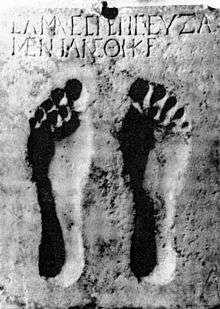Ma (goddess)
Ma was a local goddess at Comana in Cappadocia. Her name Ma means "Mother", and she also had the epithets "Invincible" and "Bringer of Victory".[1]

History
Ma has been interpreted as a mother goddess, but at the same time as a warrior goddess, as her name and epithets indicate both.[2]
She was associated with the transition of adulthood of both genders, and sacred prostitution was practiced during her biennial festivals.[3]
Ma was also seen as a moon goddess, being associated with the Anatolia moon god Mēn, with a temple estate dedicated to Mēn Pharnakou and Selene at Ameria, near Cabira, in the Kingdom of Pontus, being an attempt to counter-balance the influence of the Moon goddess Ma of Comana.
Ma has been identified with a number of other deities, indicating her function. She has been compared to Cybele and Bellona. The ancient Greeks compared Ma to the goddess Enyo and Athena Nicephorus.[4] Plutarch likened her with Semele and Athena.[5] Ma was introduced and worshiped in Macedonia together with other foreign deities.[6][7]
Ma-Enyo, a fusion between the Anatolian goddess Ma and the Greek Goddess, Enyo, was considered the great west Asian nature-goddess, with Comana's temple and its fame in ancient times as the place where the rites of this, a variety of the nature goddess, were celebrated with much solemnity.
Cult
Ma is described as a local Anatolian goddess, with her cult centered around her temple at Komana in Cappadocia. Her temple in Comana is described at length by Strabo (XI, 521; XII, 535, 537).
See also
References
- Jeroen Poblome: Exempli Gratia: Sagalassos, Marc Waelkens and Interdisciplinary ..., Volym 69
- Jeroen Poblome: Exempli Gratia: Sagalassos, Marc Waelkens and Interdisciplinary ..., Volym 69
- Jeroen Poblome: Exempli Gratia: Sagalassos, Marc Waelkens and Interdisciplinary ..., Volym 69
- Mørkholm, Otto (1991). Early Hellenistic Coinage from the Accession of Alexander to the Peace of Apamaea (336-188 B.C.). Cambridge University Press. p. 132. ISBN 978-0521395045.
- Jeroen Poblome: Exempli Gratia: Sagalassos, Marc Waelkens and Interdisciplinary ..., Volym 69
- Hecate - Enodia "Enodia’s name is accompanied by the definition “goddess”, thus showing that Enodia was a foreign deity who came to Macedonia, like Dea Syria, the Cappadocian goddess Ma, the Phrygian goddess Nemesis, and the Mother of the Gods."
- Ma "Her cult was also diffused in Macedonia, where it was introduced after the campaign of Alexander the Great and was disseminated relatively easily, perhaps because the goddess had many similarities with the Mother of the Gods, Artemis and various local deities."
- Yulia Ustinova, The Supreme Gods of the Bosporan Kingdom: Celestial Aphrodite and the Most High God (1999), p. 138.
- Robin Lane Fox, Pagans and Christians (1988), p. 536.
- George Perrot, 'History of Art in Phrygia, Lydia, Caria and Lycia (2007), p. 30.